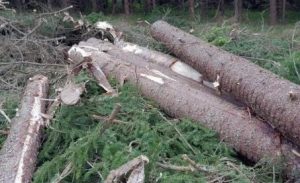According to a report by the Swedish Forest Industries, the Swedish forest industry is doing well. The report informs about the status of the lumber market after that Russia’s wood export to Europe has ceased. Russia is (was?) the World’s largest exporter of sawn timber/lumber since it recently passed Canada on that position (Sweden holds third position). Approx. 10 million cubic meters of Russia’s export went to Europe. The main importers of Russian lumber in Europe were the Baltic States (Estonia, Latvia, and Lithuania), Finland, Germany, and the United Kingdom (UK).
Full steam ahead at the Swedish sawmills
For Russia, the export to Europe represents 1/6 of their total export. For Europe, on the other hand, we are talking about 10 percent of the total consumption. A gap that now must be filled. The total net export from Europe is 25 million cubic meters of sawn timber. So, countries that have a significant production of lumber should be able to redistribute lumber from export to the domestic market. Examples of such countries are The Baltic States, Finland, and Germany.
Theoretically, Europe should be able to cover the loss of Russian lumber by exporting less to countries outside of Europe. But it depends both on the World Market and the internal European market. E.g., the UK is the largest importer of lumber from the Baltic States. If the Baltic States decides to decrease or stop, their export to the UK to favor the home market, the UK will have to search for lumber elsewhere meaning that someone else must redirect their lumber flow. This may not be so easy as many suppliers are stuck in deals with customers outside of Europe.
In the meantime, the North American market still has a great demand for lumber. That market is not saturated, and Canada has increasing difficulties supplying the USA with the vast volumes that they demand, which is a consequence of decreasing felling due to previous bark-beetle damages.
A golden opportunity for the Swedes?
The forecast for the coming 5 – 10 years is that the demand for lumber will increase significantly due to the growing interest in sustainable building and “green thinking” in general. The Swedish Forest Industries does not believe that Russia will come back as the leading exporter of lumber to the World during that period. So, where shall the lumber come from?
This should be good news for the Swedish sawmilling industry. But in the report, the Swedish Forest Industries point out problems like “the market is under pressure” and that bottlenecks in the logistic chains will prevent the sawmills that could increase their production, from delivering the lumber.
As for the logistic problems, shortage of trucks and truck drivers (who have returned to their home countries) are mentioned in the report. The question that occurs is if the number of Ukrainian, Belarussian, and Russian trucks and drivers was that high that it matters?
Is the industry afraid of increased timber prices?
The picture that is presented in the report about the future of the forest industry is bright. It seems that the high price levels for lumber that were reached in 2021 are here to stay. But instead of focusing on the possibilities, problems like “increased pressure”, “imbalance”, “insecurity for the consumers”, and “bottlenecks” are pointed out as if it was an attempt to lower the expectations or hold back the optimism. Are they afraid that the Swedish timber won’t stay the cheapest in Europe anymore?
The Swedish sawmills plan to invest after the record year 2021. Higher capacity in the existing sawmills, as well as new mills, are planned. In other words, more bulk production. But considering the forecasted increasing demand for wood and wood products in the coming 5 – 10 years and the fact that Sweden most likely will not be able to get enough timber out of the forest to meet the demands for lumber; Why is so much invested in sawmills?
New products
Why not invest at least some in engineered wood products, EWP? A lot of components that could replace lumber can be made of timber of lower qualities, such as OSB boards and OSB beams. EWP is common in many countries, like the USA and Russia, but not in Sweden. Could it be that the pulp industry is afraid of competition for pulpwood?
The availability of good quality timber in Sweden decreases due to intensive forest management to feed the pulp mills with pulpwood. Furthermore, EWP is better as carbon storage than paper products, a theme that is increasingly important not least within the EU (where Sweden is a member). Therefore, it’s hard to understand why no more effort is made to transfer at least some of the forest industry in the country into EWP.
What’s in it for the forest owners?
The forest owners are not even mentioned in the report. It’s strange as they are quite important – they are the ones that should deliver the timber. The more efficient industry will demand more timber. There is already a “wood rebellion” going on and the risk that such actions will increase if the forest owners don’t get a decent share of the cake is big.
Some of the major forest industries have their own forests, especially in northern Sweden. But in total, some 50 percent of the forest land in Sweden is owned by private forest owners. In the south that share is much higher. So, the private forest owners are important for the industry as they are one of the main suppliers of raw materials. As the forest industry is experiencing golden ages for the moment, and in the future, as it seems, one might think that the forest owners deserve more recognition. Not to mention money …
This article is based on an article signed Torbjörn Johnsen from the sister-site Skogsforum.se.












